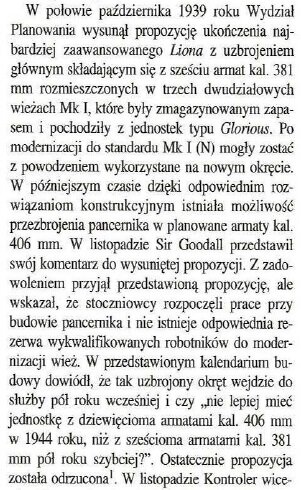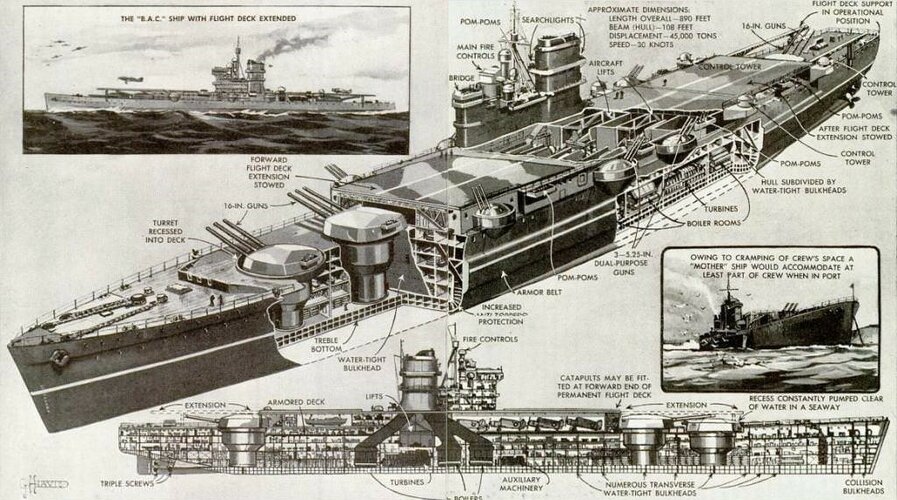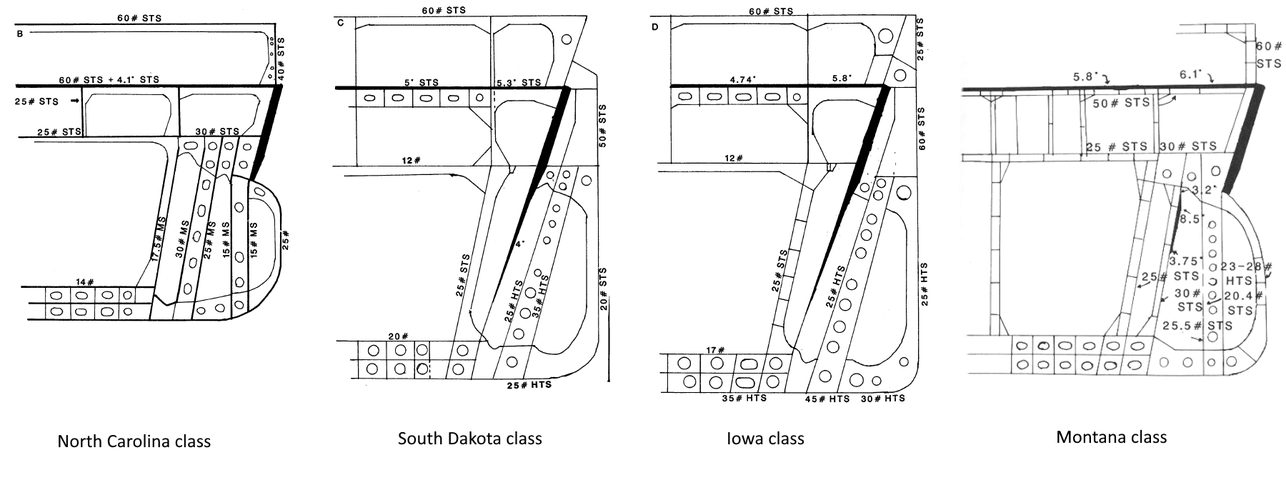Thank you very much! This is what I need!But if I decode correctly what you mention is DNC's proposal to speed up battleship construction by using the already existing 15" turrets of Courageous and Glorious as the RN had a bottleneck for bug turret construction.
You are using an out of date browser. It may not display this or other websites correctly.
You should upgrade or use an alternative browser.
You should upgrade or use an alternative browser.
Royal Navy Lion Class Battleship series 1938-1945
I am so sorry, you can repeat it? Files have already been deletedFor the time being here are the official original plans of the 1938 Lions as ordered:
Lion 1938 - Google Drive
drive.google.com
[1938] Lion - Google Drive
 drive.google.com
drive.google.com
Here's a permanent link
- Joined
- 8 January 2006
- Messages
- 1,612
- Reaction score
- 763
Truly a fascinating assemblage of information and illustration of design evolution. Amidst all this data, did anything show up regarding proposed battle-carrier hybrid warships based on the Lion class? I have seen some mention of them but not a lot about them.
- Joined
- 1 February 2011
- Messages
- 2,941
- Reaction score
- 3,624
There were some but it took me quite the time to draw these Lion designs so I had no energy or more like no motivation to draw those as well.
Two variants seems to be considered the one where the aft turret got removed and a flight deck erected from the second turret to the aft of the ship: (Basically a mix of Lion and Ark Royal/Illustrious)

And a version with an inclined flight deck though much less deck space as all 3 turrets were remained:

Two variants seems to be considered the one where the aft turret got removed and a flight deck erected from the second turret to the aft of the ship: (Basically a mix of Lion and Ark Royal/Illustrious)

And a version with an inclined flight deck though much less deck space as all 3 turrets were remained:
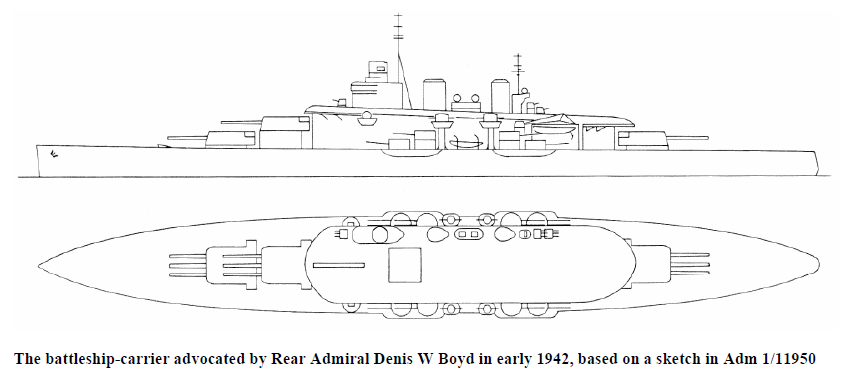
Thank you very much!Here's a permanent link
Translation of an article:Polish article describing a proposal to arm the Lion with 15-inch turrets.
In mid-October 1939, the planning department put forward a proposal to complete the construction of an improved Lion, armed with six 381mm guns housed in three two-turret Mk I, taken from the Glorious-class cruisers. After upgrading to Mk I (N), they could be successfully installed on a new ship.
Later, it was possible to rearm with 406-mm guns. Sir Goodall in November
commented on the proposal. He noted that it is possible, but the work is planned and there are no free workers to modernize the towers. By working calendar
he showed that a ship with such weapons would be ready six months earlier, and wouldn't it be better
have a ship with nine 406-mm guns
In 1944 than with six guns 381
mm six months faster? “Ultimately, the offer was rejected.
- Joined
- 1 February 2011
- Messages
- 2,941
- Reaction score
- 3,624
No mention in books. Possibly related to the pre Vanguard design I've mentioned previously to speed up BB construction. Will try to check in the Lion papers if they contains any mentions to this 3x2 arrangement.
Thank you in advance!Will try to check in the Lion papers if they contains any mentions to this 3x2 arrangement.
Moore in "Building for Victory" also refers to the 3x2 arrangement. The reference by the DNC to only saving 6 months was in a memo dated 29 Nov 1939. There was a further joint minute signed by the DNC, DNO and EinC that squashed the idea and the Controller then dropped the idea. The ref he gives is to ADM 1 10141.
So I doubt that the idea even gained enough traction at that stage to be considered for any kind of even outline design work.
But that was not the first suggestion of a 3x2 15" gunned ship. Ideas for using the spare 15" turrets had been around since Jan 1939. In Feb Goodall produced 3 alternative "ideas" being one with 6x16" in 2 turrets, or 8x15" in 4 turrets or 6x15" in 3 turrets, possibly for purchase by Australia. Speed of the latter was to be 29.5-31kts with KGV levels of protection on 33,500 tons at a cost of £5.25m. That was followed by a suggestion to replace the second 1939 Lion (Thunderer) with a 15" gunned battleship, then by July 1939 to include the proposed 15" gunned ship as an addition to the 1940 programme.
By 3 Dec 1939 Churchill, following a meeting with the DCNS, was asking for plans for a "battleship-cruiser" using 4x2 15" turrets. And Sir Stanley Goodall's diary of 30 Nov refers to the same type of ship. But this is just the resurrection of the previous ideas, which Goodall was not keen on.
So I doubt that the idea even gained enough traction at that stage to be considered for any kind of even outline design work.
But that was not the first suggestion of a 3x2 15" gunned ship. Ideas for using the spare 15" turrets had been around since Jan 1939. In Feb Goodall produced 3 alternative "ideas" being one with 6x16" in 2 turrets, or 8x15" in 4 turrets or 6x15" in 3 turrets, possibly for purchase by Australia. Speed of the latter was to be 29.5-31kts with KGV levels of protection on 33,500 tons at a cost of £5.25m. That was followed by a suggestion to replace the second 1939 Lion (Thunderer) with a 15" gunned battleship, then by July 1939 to include the proposed 15" gunned ship as an addition to the 1940 programme.
By 3 Dec 1939 Churchill, following a meeting with the DCNS, was asking for plans for a "battleship-cruiser" using 4x2 15" turrets. And Sir Stanley Goodall's diary of 30 Nov refers to the same type of ship. But this is just the resurrection of the previous ideas, which Goodall was not keen on.
Probably yes.So I doubt that the idea even gained enough traction at that stage to be considered for any kind of even outline design work.
The irony is that only this project could have been completed during the war. Without the Vanguard, of course.
Last edited:
Brickmuppet
ACCESS: Secret
- Joined
- 6 September 2006
- Messages
- 4,838
- Reaction score
- 9,481
This was captioned on Pintrest as coming from Popular Mechanics. However I think it's actually from Modern Mechanics.
The 'B.A.C." concept has nothing to do with the Lion-class, or the Admiralty, at all. Its actually from The London Illustrated News, 20th June 1942 issue. The artist is that paper's regular naval artist, G. H. Davis. The design comes from Davis's own mind (and those infamous "anonymous naval experts" that always crop up to add some substance to an artist's fantasy).
It is purely a fantasy design, probably inspired by the events in the Mediterranean War up to that point. It has numerous technical flaws, not to mention the sliding landing deck extensions.
In the next issue, Davis added to the design four 50ft MTBs/MGBs in a hangar aft launched via the fantail, just to add some additional craziness.
The two images Tzoli posted above are from The Hybrid Warship by R. D. Layman & Stephen McLaughlin, Conway Press, 1991.
The first is a double reconstruction, a sketch based on a sketch in Antony Preston's Battleships 1856-1977 which was illustrating a hybrid Lion the DNC had drawn up in March 1941. This original sketch is lost. All we know is that all the main turrets were retained and the flight deck was too short. It had been the Controller, Rear Admiral Bruce Fraser who had asked the DNC, Goodall to base the hybrid design on Lion - Fraser pointedly rejected a hybrid based on Vanguard, presumably because she was more urgently wanted than the Lions.
Apparently the meeting hated the design. They proposed a Nelson-style arrangement of all turrets forward but they feared this would make the ship 50-55,000 tons. So it seems that the official design would have been a three-turret ship (A, B, Y layout). Preston's sketch was an illustration (I have never seen the 1977 original), we don't know what secondaries or dedicated carrier features were planned.
It was at this 12th March 1941 meeting that the Director of Plans proposed two quadruple turrets rather than the Nelson layout and sketched a doodle, which has ever since been interpreted - wrongly - as being based on Richelieu (which I have debunked elsewhere).
In any case by that September the official hybrid ship was dead.
The second drawing is based on a sketch by Rear Admiral Denis W Boyd, Flag Officer Mediterranean Aircraft Carriers. He submitted a report on 'Capital Ship Design' to Admiral Cunningham (C-in-C Med) in early 1942, no doubt heavily influenced by the destruction of Z Force a few weeks earlier. His proposal included a sketch of a hybrid battleship; 45,000 tons, 800 x 100 ft, 9x 15in or 16in guns, 16x 5.25in guns or smaller, an 80ft wide flight deck (wider if beam was increased to 110ft). It was simply a sketch and not with necessarily with Lion in mind at all. Cunningham sent the report to the Admiralty.
Goodall looked at it but as his own designs had been rejected as deeply flawed, this unsolicited design was of no interest.
It was three months later that Davis' 'B.A.C.' ship then appeared in The London Illustrated News. It was the fad of the time and quickly faded away. But only that lost 1941 Goodall plan is the genuine Lion-based hybrid (two hybrid cruisers of the time also disappeared).
- Joined
- 1 February 2011
- Messages
- 2,941
- Reaction score
- 3,624
This was captioned on Pintrest as coming from Popular Mechanics. However I think it's actually from Modern Mechanics.
Apparently the meeting hated the design. They proposed a Nelson-style arrangement of all turrets forward but they feared this would make the ship 50-55,000 tons. So it seems that the official design would have been a three-turret ship (A, B, Y layout). Preston's sketch was an illustration (I have never seen the 1977 original), we don't know what secondaries or dedicated carrier features were planned.
It was at this 12th March 1941 meeting that the Director of Plans proposed two quadruple turrets rather than the Nelson layout and sketched a doodle, which has ever since been interpreted - wrongly - as being based on Richelieu (which I have debunked elsewhere).
I presume you mean this drawing with Eagle like wing shaped superstructure and 4,5" BD mounts:
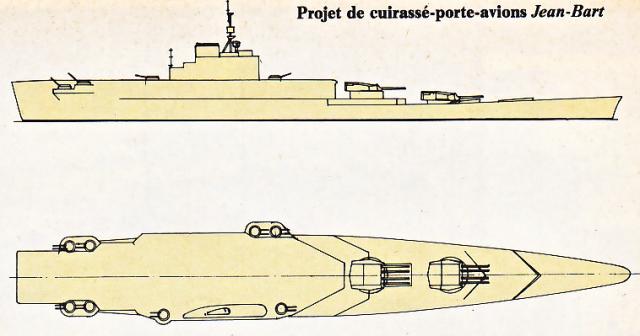
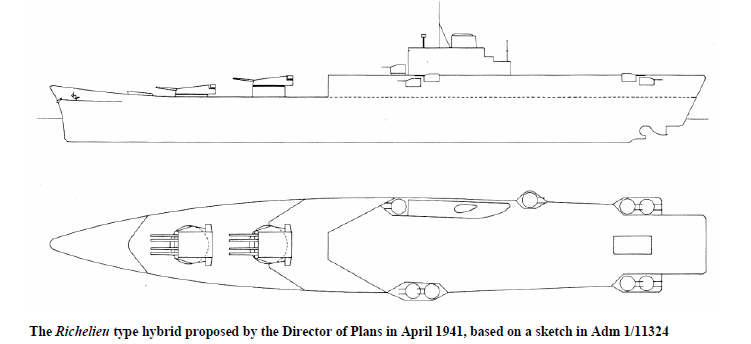
(Yes I've taken those two "Lion" BBCV Drawings from that Hybrid Warships book)
Last edited:
- Joined
- 8 January 2006
- Messages
- 1,612
- Reaction score
- 763
I keep thinking that the "Lion" BBCV could have been used as a starting point for something akin to a FACES II conversion of HMS Vanguard had she survived long enough. It would look good with Sea Harriers.
David Chessum
ACCESS: Restricted
There are two separate documents from ADM 1/11324 (Aircraft in capital ships: discussions on projected design of a Battle Carrier) included in NRS volume 159.
They cover two separate hybrid proposals, along with sketch drawings.
Regards
David
| The Fleet Air Arm in the Second World War Volume I, 1939-1941: Norway, the Mediterranean and the Bismarck |
Regards
David
Any fast battleship will look good in the Falkland Islands War. Of course equipped with SAM.It would look good with Sea Harriers.
Conspirator
CLEARANCE: L5
- Joined
- 14 January 2021
- Messages
- 324
- Reaction score
- 230
a very interesting design i must say. but dont you think the armour on the sides is a bit thin?
- Joined
- 1 February 2011
- Messages
- 2,941
- Reaction score
- 3,624
which?a very interesting design i must say. but dont you think the armour on the sides is a bit thin?
Conspirator
CLEARANCE: L5
- Joined
- 14 January 2021
- Messages
- 324
- Reaction score
- 230
which?a very interesting design i must say. but dont you think the armour on the sides is a bit thin?
basically all of the models on the first page. its only 124mm thick which if i am correct the uss missouri had 250 or so i mean with just one 5.00 inch round could go right throughwhich?a very interesting design i must say. but dont you think the armour on the sides is a bit thin?
- Joined
- 1 February 2011
- Messages
- 2,941
- Reaction score
- 3,624
The Iowa class had good armour but far from best with Lion actually had much better armour!which?a very interesting design i must say. but dont you think the armour on the sides is a bit thin?basically all of the models on the first page. its only 124mm thick which if i am correct the uss missouri had 250 or so i mean with just one 5.00 inch round could go right throughwhich?a very interesting design i must say. but dont you think the armour on the sides is a bit thin?
Iowa: 120mm Deck with deck edge near the belt being 147mm deck above both magazines and machinery eg Uniform thickness, Belt 310mm
Lion (1938 ordered version): 127mm Deck at Machinery and 152mm at Magazines and 381mm uniform Belt, earlier versions had 351mm Belt at Machinery and 381mm at Magazines.
So single plate thickness of Lion is much better especially the Belt that of the Iowas.
Also forget any game you played. No 5" shell of WW2 heritage could penetrate the armour of these battleships.
Conspirator
CLEARANCE: L5
- Joined
- 14 January 2021
- Messages
- 324
- Reaction score
- 230
i see..... i was wrong. i stand corrected. thank you. still what could be the engineering limitations to it though???The Iowa class had good armour but far from best with Lion actually had much better armour!which?a very interesting design i must say. but dont you think the armour on the sides is a bit thin?basically all of the models on the first page. its only 124mm thick which if i am correct the uss missouri had 250 or so i mean with just one 5.00 inch round could go right throughwhich?a very interesting design i must say. but dont you think the armour on the sides is a bit thin?
Iowa: 120mm Deck with deck edge near the belt being 147mm deck above both magazines and machinery eg Uniform thickness, Belt 310mm
Lion (1938 ordered version): 127mm Deck at Machinery and 152mm at Magazines and 381mm uniform Belt, earlier versions had 351mm Belt at Machinery and 381mm at Magazines.
So single plate thickness of Lion is much better especially the Belt that of the Iowas.
Also forget any game you played. No 5" shell of WW2 heritage could penetrate the armour of these battleships.
Conspirator
CLEARANCE: L5
- Joined
- 14 January 2021
- Messages
- 324
- Reaction score
- 230
turret angles/range. stuff like that cause im just seeing all the good stuff which is fine but if there are limitations(which there are) we could discuss or draw up things they could have done differently to improve it.Care to elaborate? Engineering limitations to what?
- Joined
- 1 February 2011
- Messages
- 2,941
- Reaction score
- 3,624
I suggest start reading naval related books. I suggest Norman Friedman's books, he covers RN and USN ship types, from Submarines to Carriers and maybe even have a book on warship or at least battleship design.
Warship design and development is a complex thing for which I might be alone too small.
But you can reduce it to 3+1 major aspects:
Armament
Protection
Machinery
And to connect all these: Hull
It is well accepted truth that among the first three you have to sacrifice something to gain in the other two otherwise you might either end up an oversized ship or never finish the design (What happened to the Lion class)
These aspects change in each era:
Before 20th century main and secondary armament was equally important secondary maybe even more together with protection
Before, during and shortly after WW1 the main armament become more important as well as speed
Before and during WW2 Torpedo Protection and AA defence was the priority while sensors gaining importance
After WW2 speed Senors, and AA defence become no.1
The Major Aspects can be further divided:
Armament:
- Main armament (number of guns, turrets, turret types, ammo)
- Secondary armament (same as above plus added dual or single purpose capability)
- Tertiary or other armament
- Heavy and Light AA Armament
- Torpedo and ASW armament
Protection:
- Belt armour (Layout, Inclination)
- Deck armour
- Underwater protection
Machinery
- Type of machinery (Vertical Triple Expansion, Steam Turbines, Gas Turbines, Diesel etc)
- Type of fuel
- Size and Weight
- Layout
Hull:
- Dimensions and Shape
- Type (Flush deck, Broken, Turtle, Stealthy etc)
- Bow and Stern type
Warship design and development is a complex thing for which I might be alone too small.
But you can reduce it to 3+1 major aspects:
Armament
Protection
Machinery
And to connect all these: Hull
It is well accepted truth that among the first three you have to sacrifice something to gain in the other two otherwise you might either end up an oversized ship or never finish the design (What happened to the Lion class)
These aspects change in each era:
Before 20th century main and secondary armament was equally important secondary maybe even more together with protection
Before, during and shortly after WW1 the main armament become more important as well as speed
Before and during WW2 Torpedo Protection and AA defence was the priority while sensors gaining importance
After WW2 speed Senors, and AA defence become no.1
The Major Aspects can be further divided:
Armament:
- Main armament (number of guns, turrets, turret types, ammo)
- Secondary armament (same as above plus added dual or single purpose capability)
- Tertiary or other armament
- Heavy and Light AA Armament
- Torpedo and ASW armament
Protection:
- Belt armour (Layout, Inclination)
- Deck armour
- Underwater protection
Machinery
- Type of machinery (Vertical Triple Expansion, Steam Turbines, Gas Turbines, Diesel etc)
- Type of fuel
- Size and Weight
- Layout
Hull:
- Dimensions and Shape
- Type (Flush deck, Broken, Turtle, Stealthy etc)
- Bow and Stern type
Conspirator
CLEARANCE: L5
- Joined
- 14 January 2021
- Messages
- 324
- Reaction score
- 230
im thinking about splitting ammunition 50/50 armour piercing/high explosive rounds but the question is this: smaller rounds(less effective) but more ammo or bigger guns less ammo but better effectiveness? im thinking 16. in guns .50 cal anti air + 7.62's meybe? and dual 2. in guns on the sides for close combat. just a start.
- Joined
- 29 September 2006
- Messages
- 1,794
- Reaction score
- 1,362
turret angles/range. stuff like that cause im just seeing all the good stuff which is fine but if there are limitations(which there are) we could discuss or draw up things they could have done differently to improve it.Care to elaborate? Engineering limitations to what?
Engineering matters are covered well in D K Brown’s series of books on the development of the Royal Navy. “Rebuilding the Royal Navy” deals with postwar developments, and so only has a little on battleships. “Nelson to Vanguard” covers the interwar period and WWII and has a lot.
Brown was a naval architect for the RN, and so has a lot of insights into policy and design. However, I am not a total battleship nut, so don’t consider getting either of the books mentioned unless another battleship fan seconds it.
Personally speaking though, as a postwar navy nut, I learned a hell of a lot from “Rebuilding the Royal Navy”.
- Joined
- 1 February 2011
- Messages
- 2,941
- Reaction score
- 3,624
I suggest these books: If you read them you will gain an insight how to design a working warship what sacrifices the various designers had to make or accept for the ships to be built,
Norman Friedman:
Battleship design and development
U.S. Submarines through 1945: An Illustrated Design History
U.S. Submarines since 1945: An Illustrated Design History
U.S. Destroyers: An Illustrated Design History
U.S. Cruisers: An Illustrated Design History
U.S. Battleships: An Illustrated Design History
U.S. Aircraft Carriers: An Illustrated Design History
British Destroyers & Frigates: The Second World War & After
British Cruisers of the Victorian Era
British Cruisers: Two World Wars and After
British Battleships of the Victorian Era
The British Battleship: 1906-1946
David Hobbs:
British Aircraft Carriers: Design, Development & Service Histories
Eric Lacroix:
Japanese Cruisers of the Pacific War
Janusz Skulski:
Battleships Yamato and Musashi (Anatomy of The Ship)
Also yes the various David K. Brown books:
Nelson to Vanguard: Warship Design and Development, 1923–1945
Rebuilding the Royal Navy: Warship Design Since 1945
John Jordan:
French Battleships of World War One
French Battleships 1922-1956
and the various Conway books: (Though these are more like encyclopaedias they still offer some insight to a nation's building policy and you can get good stats (Dimension armament engines etc) of the various classes the world navies used or intended to use.
Conway's All the World's Fighting Ships, 1860-1905
Conway's All the World's Fighting Ships, 1906-1921
Conway's All the World's Fighting Ships, 1922-1946
Conway's All the World's Fighting Ships, 1947-1995
You can get buy these books we offered via hardcopy or as digital copy from various sites or if you ask the right person or right forum member who have them in PDF format.
Norman Friedman:
Battleship design and development
U.S. Submarines through 1945: An Illustrated Design History
U.S. Submarines since 1945: An Illustrated Design History
U.S. Destroyers: An Illustrated Design History
U.S. Cruisers: An Illustrated Design History
U.S. Battleships: An Illustrated Design History
U.S. Aircraft Carriers: An Illustrated Design History
British Destroyers & Frigates: The Second World War & After
British Cruisers of the Victorian Era
British Cruisers: Two World Wars and After
British Battleships of the Victorian Era
The British Battleship: 1906-1946
David Hobbs:
British Aircraft Carriers: Design, Development & Service Histories
Eric Lacroix:
Japanese Cruisers of the Pacific War
Janusz Skulski:
Battleships Yamato and Musashi (Anatomy of The Ship)
Also yes the various David K. Brown books:
Nelson to Vanguard: Warship Design and Development, 1923–1945
Rebuilding the Royal Navy: Warship Design Since 1945
John Jordan:
French Battleships of World War One
French Battleships 1922-1956
and the various Conway books: (Though these are more like encyclopaedias they still offer some insight to a nation's building policy and you can get good stats (Dimension armament engines etc) of the various classes the world navies used or intended to use.
Conway's All the World's Fighting Ships, 1860-1905
Conway's All the World's Fighting Ships, 1906-1921
Conway's All the World's Fighting Ships, 1922-1946
Conway's All the World's Fighting Ships, 1947-1995
You can get buy these books we offered via hardcopy or as digital copy from various sites or if you ask the right person or right forum member who have them in PDF format.
Conspirator
CLEARANCE: L5
- Joined
- 14 January 2021
- Messages
- 324
- Reaction score
- 230
wow okay that was a lot of reading and research had some trouble finding a few but managed to. so this specific class was a new attempted redesign that did not make production. was a great design never the less the lion class brought the best of all the other classes to one shipI suggest these books: If you read them you will gain an insight how to design a working warship what sacrifices the various designers had to make or accept for the ships to be built,
Norman Friedman:
Battleship design and development
U.S. Submarines through 1945: An Illustrated Design History
U.S. Submarines since 1945: An Illustrated Design History
U.S. Destroyers: An Illustrated Design History
U.S. Cruisers: An Illustrated Design History
U.S. Battleships: An Illustrated Design History
U.S. Aircraft Carriers: An Illustrated Design History
British Destroyers & Frigates: The Second World War & After
British Cruisers of the Victorian Era
British Cruisers: Two World Wars and After
British Battleships of the Victorian Era
The British Battleship: 1906-1946
David Hobbs:
British Aircraft Carriers: Design, Development & Service Histories
Eric Lacroix:
Japanese Cruisers of the Pacific War
Janusz Skulski:
Battleships Yamato and Musashi (Anatomy of The Ship)
Also yes the various David K. Brown books:
Nelson to Vanguard: Warship Design and Development, 1923–1945
Rebuilding the Royal Navy: Warship Design Since 1945
John Jordan:
French Battleships of World War One
French Battleships 1922-1956
and the various Conway books: (Though these are more like encyclopaedias they still offer some insight to a nation's building policy and you can get good stats (Dimension armament engines etc) of the various classes the world navies used or intended to use.
Conway's All the World's Fighting Ships, 1860-1905
Conway's All the World's Fighting Ships, 1906-1921
Conway's All the World's Fighting Ships, 1922-1946
Conway's All the World's Fighting Ships, 1947-1995
You can get buy these books we offered via hardcopy or as digital copy from various sites or if you ask the right person or right forum member who have them in PDF format.
Conspirator
CLEARANCE: L5
- Joined
- 14 January 2021
- Messages
- 324
- Reaction score
- 230
yes that was a redesign and anti aircraft weaponry was the most importantExcept for main weaponry that would be HMS Vanguard, likely the best AA armed battleships together with her Radar AA Directors
PCOYAW
ACCESS: Restricted
- Joined
- 28 December 2020
- Messages
- 2
- Reaction score
- 0
15in thickness was the most impressive except Yamato, so was the belt width. I don't see any other ships have wider belt than the last series of RN battleships.The Iowa class had good armour but far from best with Lion actually had much better armour!which?a very interesting design i must say. but dont you think the armour on the sides is a bit thin?basically all of the models on the first page. its only 124mm thick which if i am correct the uss missouri had 250 or so i mean with just one 5.00 inch round could go right throughwhich?a very interesting design i must say. but dont you think the armour on the sides is a bit thin?
Iowa: 120mm Deck with deck edge near the belt being 147mm deck above both magazines and machinery eg Uniform thickness, Belt 310mm
Lion (1938 ordered version): 127mm Deck at Machinery and 152mm at Magazines and 381mm uniform Belt, earlier versions had 351mm Belt at Machinery and 381mm at Magazines.
So single plate thickness of Lion is much better especially the Belt that of the Iowas.
Also forget any game you played. No 5" shell of WW2 heritage could penetrate the armour of these battleships.
But emmmm...... the belt was vertical, only a bit inclined around the turrets. As I recall the 1920/21 series had the most forward looking inclined belt design. I'm quite frustrated why RN changed it back on KGV, Lion and Vanguard. Only for close battles?
- Joined
- 5 May 2007
- Messages
- 1,483
- Reaction score
- 2,860
Internal, inclined belts aren't a panacea - they make internal arrangement more difficult, are more difficult to install or repair, and sacrifice stability after internal damage. An external belt is preferable on all counts; these can be inclined, but that forces you towards a less desirable hullform.But emmmm...... the belt was vertical, only a bit inclined around the turrets. As I recall the 1920/21 series had the most forward looking inclined belt design. I'm quite frustrated why RN changed it back on KGV, Lion and Vanguard. Only for close battles?
The Royal Navy looked at the alternatives, and decided that the benefits of an inclined belt weren't worth the problems they caused elsewhere.
Remember, all design is tradeoff. There isn't one Optimum Solution that everyone is converging on, and two design teams will make different tradeoffs.
It's worth remembering that VANGUARD was basically the LION design with greater length and modified internal arrangements to suit the available armament.Except for main weaponry that would be HMS Vanguard, likely the best AA armed battleships together with her Radar AA Directors
- Joined
- 1 May 2007
- Messages
- 2,596
- Reaction score
- 1,966
15in thickness was the most impressive except Yamato, so was the belt width. I don't see any other ships have wider belt than the last series of RN battleships.The Iowa class had good armour but far from best with Lion actually had much better armour!which?a very interesting design i must say. but dont you think the armour on the sides is a bit thin?basically all of the models on the first page. its only 124mm thick which if i am correct the uss missouri had 250 or so i mean with just one 5.00 inch round could go right throughwhich?a very interesting design i must say. but dont you think the armour on the sides is a bit thin?
Iowa: 120mm Deck with deck edge near the belt being 147mm deck above both magazines and machinery eg Uniform thickness, Belt 310mm
Lion (1938 ordered version): 127mm Deck at Machinery and 152mm at Magazines and 381mm uniform Belt, earlier versions had 351mm Belt at Machinery and 381mm at Magazines.
So single plate thickness of Lion is much better especially the Belt that of the Iowas.
Also forget any game you played. No 5" shell of WW2 heritage could penetrate the armour of these battleships.
But emmmm...... the belt was vertical, only a bit inclined around the turrets. As I recall the 1920/21 series had the most forward looking inclined belt design. I'm quite frustrated why RN changed it back on KGV, Lion and Vanguard. Only for close battles?
Isn't a vertical belt MORE efficient . . . as in the incoming fire, unless it's at point-blank range, arrives at some angle of descent, therefore, to the incoming shell's view, a vertical belt IS inclined . . .
cheers,
Robin.
- Joined
- 1 February 2011
- Messages
- 2,941
- Reaction score
- 3,624
I've asked the same question on the battlecruisers forum:
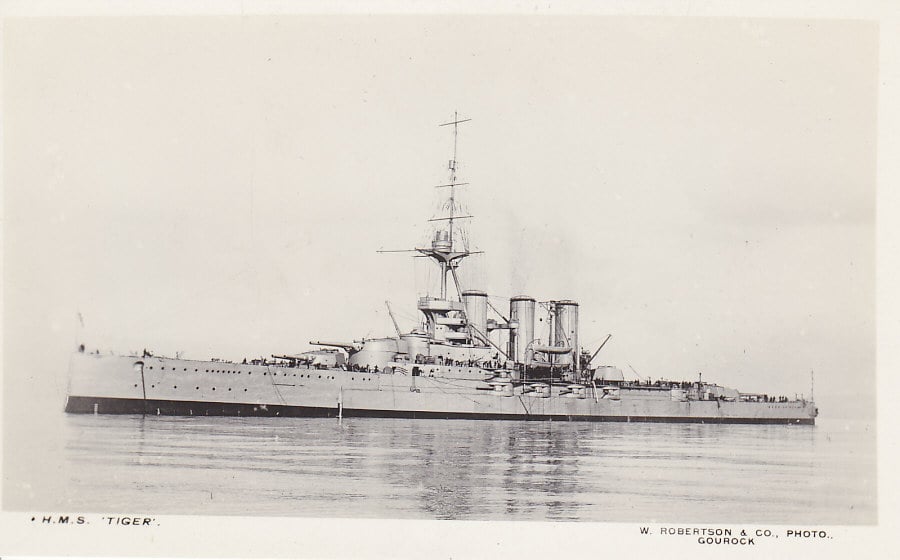
 www.tapatalk.com
www.tapatalk.com
And the consensus on the RN part apart from what you said as Inclined armour had to be inside the hull and thus makes repair difficult and requires (in my opinion) a minimally wider hull the other aspect is underwater defence, more precisely the damage the underwater defence system could sustain after a gunfight. A shell's parts after hitting the inclined armour might "bounce" downward into the armoured anti torpedo bulkheads, damaging them and their ability to withstand torpedo and mine damage afterwards.
I still think this is an acceptable compromise as an inclined armour could be thinner then a vertical one reducing armour weight while maintaining the same or even better protection then a pure vertical plate armour.
For example the 14" / 356mm magazine belt of Nelson inclined at 18 degrees equals to 374mm Vertical belt armour which is quite close to the 15" / 381mm of the KGV's vertical plate. If a shell arrives at a 30° this drastically changes:
For Nelson that 356mm 18° plate becomes 532mm thick while KGV's 381 0° ones become only 440mm!!!
Of course the longer the range the better inclined armoru becomes tough the chance to hit said belt reduces.

All the World's Battlecruisers-Lack of Inclined armour in RN Ships
In the Royal Navy Nelson class was the first and last warship to have inclined armour belt. No other capital ship or cruiser class built with such. Wh
And the consensus on the RN part apart from what you said as Inclined armour had to be inside the hull and thus makes repair difficult and requires (in my opinion) a minimally wider hull the other aspect is underwater defence, more precisely the damage the underwater defence system could sustain after a gunfight. A shell's parts after hitting the inclined armour might "bounce" downward into the armoured anti torpedo bulkheads, damaging them and their ability to withstand torpedo and mine damage afterwards.
I still think this is an acceptable compromise as an inclined armour could be thinner then a vertical one reducing armour weight while maintaining the same or even better protection then a pure vertical plate armour.
For example the 14" / 356mm magazine belt of Nelson inclined at 18 degrees equals to 374mm Vertical belt armour which is quite close to the 15" / 381mm of the KGV's vertical plate. If a shell arrives at a 30° this drastically changes:
For Nelson that 356mm 18° plate becomes 532mm thick while KGV's 381 0° ones become only 440mm!!!
Of course the longer the range the better inclined armoru becomes tough the chance to hit said belt reduces.
PCOYAW
ACCESS: Restricted
- Joined
- 28 December 2020
- Messages
- 2
- Reaction score
- 0
Thank you, sir. I too think the compromise is acceptable.
And what do you think of North Carolina and Montana's design? The inclined belt is placed entirely outside the hull and it seems protecting most part of the TDS (though their belt width maybe too small compared with RN new battleships XD).
And what do you think of North Carolina and Montana's design? The inclined belt is placed entirely outside the hull and it seems protecting most part of the TDS (though their belt width maybe too small compared with RN new battleships XD).
Similar threads
-
-
The Development and Modernizations of the Nelson class
- Started by Tzoli
- Replies: 36
-
-
-


